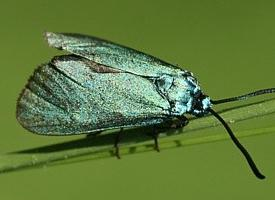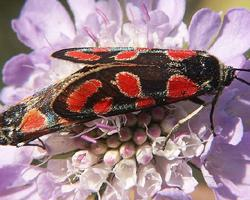
Váhy a míry
| Délka | 14 mm |
|---|---|
| Délka rozpětí křídel | 28 mm |
Popis zvířete
The Green Forester (Adscita statices) is a captivating moth species belonging to the Zygaenidae family, a group known for their bright colors and metallic sheens. This particular species is widely distributed across Europe and parts of Asia, thriving in a variety of habitats including grasslands, meadows, and open woodland areas. The Green Forester has garnered attention and appreciation not only from entomologists but also from nature enthusiasts due to its striking appearance and the role it plays in local ecosystems.Adult Green Foresters are relatively small, with a wingspan typically ranging from 14 to 18 millimeters. What sets them apart and makes them instantly recognizable is their vibrant green coloration. The upper sides of their wings are a lustrous green, often with a metallic sheen that can appear to change in intensity and hue under different lighting conditions. This dazzling coloration is not just for show; it serves as a camouflage among the green foliage where they rest during the day. The underwings are a duller grayish-green, providing a stark contrast when the moth is in flight. Their body is slender and also green, blending seamlessly with their wings.
One of the most fascinating aspects of the Green Forester is its lifecycle, which is closely intertwined with the presence of specific plant species. The larvae of the Green Forester are known to feed on a variety of herbaceous plants, with a particular preference for sorrel (Rumex species) and dock (also Rumex species). These plants serve as both food and habitat for the developing larvae, which are less conspicuous than their adult counterparts, colored in a more subdued palette of green and brown hues that help them remain undetected by predators.
After a period of feeding and growth, the larvae pupate, undergoing a remarkable transformation within a cocoon that is often attached to the stems or leaves of their host plants. The adult moths emerge from their pupal stage typically in late spring or early summer, depending on their geographical location and the local climate. The timing of their emergence is closely synced with the flowering period of many plants, allowing the adult moths to feed on nectar and participate in the pollination process.
The Green Forester is diurnal, meaning it is active during the day, which is somewhat unusual for moths. This diurnal activity pattern, coupled with their bright coloration, makes them more akin to butterflies in behavior and appearance. They are often seen flitting from flower to flower in sunny spots, adding a flash of vibrant green to the landscape.
Despite their beauty and ecological importance, Green Foresters, like many other insect species, face threats from habitat loss, agricultural intensification, and pesticide use. Conservation efforts are crucial to ensure that these moths, along with the biodiversity of the habitats they inhabit, are preserved for future generations to admire and study.
In summary, the Green Forester (Adscita statices) is a small yet strikingly colored moth that plays a significant role in the ecosystems of Europe and parts of Asia. Its lifecycle, from larva to dazzling adult, is a fascinating journey closely linked to specific host plants and the health of its natural habitats. As a symbol of the beauty and complexity of the natural world, the Green Forester serves as a reminder of the importance of conservation and the protection of biodiversity.
Podobná zvířata
Nové fotografie zvířat
Top 10 zvířat
- Dolphin gull (Leucophaeus scoresbii)
- Diana monkey (Cercopithecus diana)
- Stone loach (Barbatula barbatula)
- Greek tortoise (Testudo graeca)
- Moustached guenon (Cercopithecus cephus)
- Japanese macaque (Macaca fuscata)
- Galápagos tortoise (Geochelone nigra complex)
- Russian tortoise (Testudo horsfieldii)
- Galápagos penguin (Spheniscus mendiculus)
- Common flying dragon (Draco volans)
